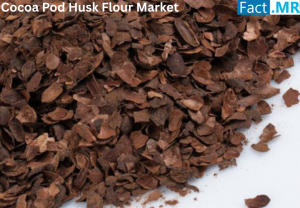Cocoa Pod Husk Flour Market is Expected to Reach USD 48.0 million with 6.0% CAGR by 2035
The global cocoa pod husk flour market outlook from 2025 to 2035, highlighting key growth drivers, regional insights, challenges, and future opportunities.
ROCKVILLE, MD, UNITED STATES, September 29, 2025 /EINPresswire.com/ -- The global cocoa pod husk flour market is projected to grow from USD 27.0 million in 2025 to approximately USD 48.0 million by 2035, recording an absolute increase of USD 21.0 million over the forecast period. This translates into a total growth of 77.8%, with the market forecast to expand at a compound annual growth rate (CAGR) of 6.0% between 2025 and 2035.Market Dynamics Driving Growth
Rising Demand for Sustainable Ingredients
Consumers are increasingly drawn toward eco-friendly and sustainable food products. Cocoa pod husk flour, being a byproduct of cocoa processing, directly supports waste reduction and resource efficiency.
Health and Nutritional Benefits
CPHF is rich in dietary fiber, antioxidants, and polyphenols, making it attractive for use in bakery, nutraceuticals, and health supplements.
Expanding Applications Across Industries
The versatility of cocoa pod husk flour is boosting its adoption across multiple industries, from food manufacturing to animal feed production.
Cocoa Pod Husk Flour Market by Segments
Application
Cocoa pod husk flour is finding strong demand in bakery products where it enriches bread, cakes, cookies, and pastries with added fiber and nutritional value. In the animal feed sector, it serves as a sustainable and cost-effective feed additive, offering essential nutrients and reducing reliance on conventional feed inputs. In nutraceuticals, its antioxidant and polyphenolic properties are highly valued in dietary supplements and functional foods. Beyond these, it also finds use in cosmetics and specialty products where natural, plant-based ingredients are valued.
Form
The powdered form dominates in bakery and nutraceutical applications because of its ease of blending with other ingredients. The pellet form, on the other hand, is preferred for animal feed applications due to ease of handling, storage, and consistent nutrient delivery.
Processing Method
Conventional processing remains the dominant method, producing affordable cocoa pod husk flour for mass applications. Organic processing is increasingly important, particularly among health-conscious consumers who seek premium and natural products in nutraceuticals and bakery items. Specialty processing, which involves advanced methods to preserve bioactive compounds, is appealing to high-value industries.
End-Use
Food manufacturers represent the leading end-use segment, incorporating cocoa pod husk flour into bakery and functional food products. Feed producers use it as a sustainable feed additive to lower costs and enhance animal nutrition. Nutraceutical companies are developing supplements and health products rich in fiber and antioxidants. Specialty ingredient suppliers provide premium-grade flour for niche applications like skincare and natural remedies.
Full Market Report available for delivery. For purchase or customization, please request here - https://www.factmr.com/connectus/sample?flag=S&rep_id=11072
For more on their methodology and market coverage, visit - https://www.factmr.com/about-company
Highlighting Recent Developments and Competitor Analysis
The competitive landscape of the cocoa pod husk flour market is evolving rapidly. Key players are investing in research to enhance processing technologies and improve the nutritional profile of CPHF. Some are partnering with cocoa-growing communities to secure sustainable raw material sources.
Food ingredient companies are launching new CPHF-based bakery mixes and health supplements to tap into the wellness trend. Animal nutrition firms are conducting trials to validate the efficacy of CPHF in feed formulations. Sustainability-driven businesses are positioning CPHF as part of circular economy models, highlighting reduced food waste and environmental impact.
Competitor strategies often revolve around certifications, such as organic and fair-trade labels, to attract premium consumers. Additionally, companies are differentiating by offering specialty-processed CPHF with higher bioactive retention, catering to nutraceutical and pharmaceutical players.
Regional Outlook
The cocoa pod husk flour market is showing varied growth patterns across regions. Latin America and Africa dominate raw material availability due to large cocoa cultivation areas, and local processing and value addition are emerging trends. Europe is a leading consumer market, driven by demand for sustainable, organic, and fiber-rich bakery products. Asia-Pacific is witnessing growing adoption in nutraceuticals and animal feed sectors. North America continues to show high demand for specialty and organic products, with strong investments in health foods and supplements.
Future Opportunities
The market outlook for CPHF remains highly promising. Investments in technological advancements such as precision drying, micro-milling, and bioactive preservation will open new growth avenues. Furthermore, collaborations between cocoa producers and ingredient suppliers will strengthen supply chain resilience and sustainability.
With rising consumer awareness, regulatory support for sustainable practices, and continuous innovation, cocoa pod husk flour is set to become a mainstream ingredient across multiple industries.
Conclusion
The cocoa pod husk flour market is on a trajectory of steady expansion, fueled by sustainability goals, nutritional benefits, and versatile applications. From bakery goods to nutraceuticals and animal feed, CPHF is proving to be a valuable byproduct that supports both economic and environmental objectives. With a projected CAGR of 6.0% between 2025 and 2035, and the market value expected to reach USD 48.0 million by 2035, the future of cocoa pod husk flour looks both profitable and sustainable.
Check out More Related Studies Published by Fact.MR Research:
Clinical Nutrition Market: https://www.factmr.com/report/clinical-nutrition-market
Crop Growth Regulator Market: https://www.factmr.com/report/crop-growth-regulator-market
Bio-Tech Flavor Market: https://www.factmr.com/report/bio-tech-flavor-market
Wheat Starch Derivative Market: https://www.factmr.com/report/wheat-starch-derivative-market
Editor’s Note:
This release is based exclusively on verified and factual market content derived from industry analysis by FactMR. No AI-generated statistics or speculative data have been introduced. This story is designed to support manufacturers, healthcare providers, and wellness brands in recognizing the Cocoa Pod Husk Flour industry as a major growth and innovation sector for the coming decade.
S. N. Jha
Fact.MR
+ +1 628-251-1583
sales@factmr.com
Legal Disclaimer:
EIN Presswire provides this news content "as is" without warranty of any kind. We do not accept any responsibility or liability for the accuracy, content, images, videos, licenses, completeness, legality, or reliability of the information contained in this article. If you have any complaints or copyright issues related to this article, kindly contact the author above.

